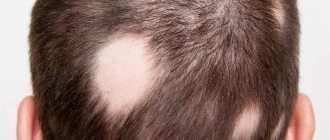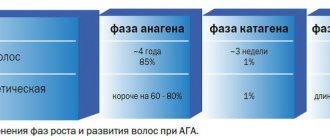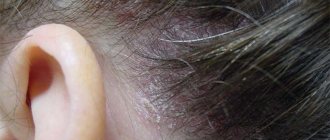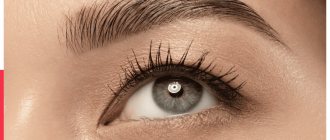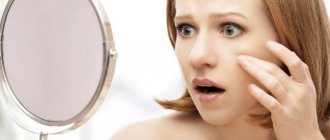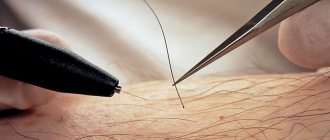Link to PubMed
Authors with positions and titles: Quan Q Dinh and Rodney Sinclair, Correspondence: Rodney Sinclair, PO Box 2900, Fitzroy 3065, Australia, Fax +613 9288 3292, Tel +613 9288 3127, Email
Imprint: Published online 2007 Jun
Less than 45% of women retain a full head of hair throughout their lives. Female pattern hair loss is the most common cause of hair loss in women and progresses with age. Women may experience psychological distress and impaired social functioning. In most cases, the diagnosis can be made clinically and treatment is carried out with medication. Many women using oral antiandrogens and topical minoxidil experience hair restoration, but early diagnosis and treatment are highly desirable as these treatments are more effective at halting the progression of hair loss than at stimulating regrowth. For some patients, additional non-drug therapies such as counseling, cosmetic camouflage, and hair transplantation are vital. Histologically, female pattern hair loss is identical to male pattern androgenetic alopecia. While clinically hereditary androgenetic alopecia varies among men, the response to topical antiandrogens suggests that most cases of female pattern androgenetic alopecia are an androgen-dependent condition. Female pattern hair loss is a chronic, progressive condition. To maintain the effect, all procedures must be constant. An initial therapeutic response often occurs after 12 or even 24 months. Given the delayed therapeutic effect, monitoring the effectiveness of treatment using clinical photographs or standardized clinical rating scales is useful. The term female androgenetic alopecia or female pattern hair loss has emerged as the preferred term for androgenetic alopecia in women due to the unclear relationship between androgens and this condition (Olsen 2001). It is characterized by a decrease in hair density on the parietal and frontal areas of the head with preservation of the frontal hair line. In 1977, Ludwig clearly described the distinctive features of female pattern hair loss and classified it into three stages of sequential diffuse hair thinning (I, II and III). The prevalence increases with age, from approximately 12% among women aged 20 to 29 years to more than 50% of women over the age of 80. Hair loss in women can cause serious psychological trauma. Cash and colleagues (1993) suggested that women place more emphasis than men on physical appearance and physical attractiveness. Social norms dictate that hair is an integral part of women's sexuality and gender identity, so any hair loss creates feelings of low self-esteem and anxiety due to a possible decrease in attractiveness. Women are more likely than men to experience reduced quality of life and limited social contacts as a result of hair loss.
Current treatments are limited, and even if the response is positive, there is a significant time delay before improvement becomes apparent. Regardless of which treatment method is chosen, sufficient time must be devoted to counseling the patient.
There are two main pharmacological therapies: antiandrogens and minoxidil. To maintain the response, both treatments must be used continuously. In some cases, non-pharmacological methods can be used: changing hairstyles, using concealing products, and hair extensions.
Treatment methods
Pharmacological
Pharmacological methods can be divided into the following: drugs with androgen-independent and androgen-dependent mechanisms of action.
Androgen-independent drugs
Minoxidil Topical minoxidil Its possible mechanism of action affects the hair growth cycle, causing premature telogen cessation, and likely prolongation of anagen. Understanding exactly how minoxidil produces these effects is currently the subject of intense research. Although the drug is available in 2% and 5% concentrations, only the 2% solution is currently approved by the FDA for the treatment of female androgenetic alopecia. A comparative study of the effectiveness of the two concentrations using hair counts in the target area over 48 weeks as the primary endpoint showed a non-significant moderate benefit for the 5% solution (Olsen et al, 2002).
Androgen-dependent drugs
The use of all androgen-dependent drugs for the treatment of female androgenetic alopecia carries a risk of developing genital abnormalities in the male fetus. Thus, these drugs are contraindicated in pregnant women, which leads many doctors to recommend that women take oral contraceptives throughout the course of treatment with these drugs. Like minoxidil, all androgen-dependent drugs must be used for at least 1 year before effectiveness can be accurately assessed.
Finasteride Finasteride Thus, finasteride inhibits total androgen activity by inhibiting the activity of total circulating androgens.
Cyproterone acetate This drug inhibits gonadotropin releasing hormone (GnRH) and blocks androgen receptors. It is also used for prostate cancer, hirsutism and severe acne. In combination with estradiol, it is used as an oral contraceptive - Diane-35.
Spironolactone Spironolactone It acts as an androgen antagonist by competitively blocking androgen receptors and also inhibits ovarian androgen production. In the United States, it is the most widely used antiandrogen for the treatment of female androgenetic alopecia. The side effects of spironolactone may be more variable than other drugs, partly due to its additive actions as an aldosterone antagonist. These include postural hypotension, electrolyte disturbances, menstrual irregularities, fatigue, urticaria, breast tenderness, and hematological disturbances.
Flutamide Flutamide It is commonly used to treat advanced prostate cancer and hirsutism. Due to the fact that the drug is one of the new antiandrogens, data on its medical use for the treatment of female androgenetic alopecia are limited. Side effects caused by flutamide are potentially serious. These include liver dysfunction, breast tenderness and are dose-dependent.
Areaty alopecia
There are many causes of hair loss - from poisoning to local or systemic infections. However, unfortunately, sometimes we don't know exactly why hair actually falls out. One of these diseases is alopecia areata, or alopecia areata.
What it is?
This is a chronic disease that affects the hair follicles and sometimes the nails. It appears in the form of rounded areas of non-scarring hair loss on the head, sometimes on the face (eyebrows, mustache, beard), as well as other areas of the skin.
What is the reason?
The reason is still unknown. There are theories of autoimmune damage to hair follicles, genetic determination of the disease and many others, but in fact we do not know why this appears and why it goes away.
What does it look like?
One fine day (or night) on the head (very rarely, primarily on other areas of the hairy skin), a lesion with fallen hair is discovered. As a rule, it does not hurt, does not itch, and sometimes there may be a slight burning sensation, which many patients at first (before the defect is discovered) do not attach importance to. Also (if “caught” at the initial stage) some patients may have slight redness of the skin. The skin on long-term lesions does not differ from normal skin.
Areas of hair loss are usually round, and there may be easily (with the slightest twitch) hair falling out and hair fragments along their edges. In severe forms of the disease, nails may be affected: dull color, thimble-shaped indentations, longitudinal striations, free edge in the form of wavy jagged edges.
How does it vary in severity?
There are local, subtotal, ophiasis, total and universal clinical forms.
- In the local form, one or more clearly defined round foci of alopecia are determined on the scalp.
- With the subtotal form, more than 30–40% of hair is missing from the scalp.
- With ophiasis, foci of alopecia cover the entire marginal zone of hair growth on the head, or the frontotemporal region, or only the back of the head.
- With the total form, there is a complete absence of hair on the scalp.
- With the universal form, there is no hair on the scalp, eyebrows, or eyelashes; on the body, vellus hair is partially or completely lost.
Alas, all forms of the disease can transform into one another.
Who to treat?
It is better to see a dermatovenerologist specializing in trichology. You cannot self-medicate; most treatment methods have significant side effects, and are even simply dangerous for general health.
How to diagnose?
Usually the diagnosis is not difficult. Typically, general tests, tests for fungi, and tests to rule out syphilis and common autoimmune diseases are performed.
Perhaps, to determine treatment tactics, a trichogram may be needed - a study of the hair roots along the edges of the lesion.
How dangerous is this? Currently, there is no convincing evidence of the connection between alopecia areata and any other specific diseases and/or pathologies. Caution should be exercised regarding autoimmune diseases.
What is the treatment?
Like all diseases whose etiology is unknown, and treatment is not always successful, the range of measures taken is quite wide, however, alas, the evidence base for many traditionally used remedies is absent or the evidence of their effectiveness is rather weak.
Glucocorticoid hormones are used systemically and locally (in the form of potent ointments and intradermal injections directly into the skin of the lesion), minoxidil, cytostatics, photochemotherapy (photosensitizers + irradiation are prescribed), local immunosuppressive therapy, tar preparations, various “folk” remedies (onion juice, tincture of capsicum pepper) and many others.
Unfortunately, analysts from the Cochrane Collaboration, comparing reports on the use of certain products, did not find evidence that at least something gives a lasting positive effect on alopecia areata.
What's the prognosis?
Fortunately, approximately 80% of patients with local forms of alopecia areata achieve remission after 12 months from the onset of the disease. Unfortunately, even these people may experience a recurrence of the disease.
For more common forms, the prognosis is significantly worse. In approximately 15–20%, it is not possible to achieve healing of the lesions, and 1–2% of patients experience complete hair loss. Such patients must get used to the idea of a wig or find motivation to be proud of their new look.
In approximately 15–20%, it is not possible to achieve healing of the lesions, and 1–2% of patients experience complete hair loss. Such patients must get used to the idea of a wig or find motivation to be proud of their new look.
The prognosis worsens with early onset of the disease (before puberty); when baldness develops on the head along the boundaries of hair growth (temple area, behind the ears, lower third of the occipital region); with pronounced changes in the nail plates; the presence of concomitant autoimmune and atopic diseases in patients.
Since we do not know what causes alopecia areata, there are no special measures to prevent the disease/recurrences.
Since the problem is cosmetic in nature and associated with social adaptation, most patients at one stage or another of the disease need the help of a psychologist or psychotherapist.
Good health!
Leonid Shchebotansky
Photo istockphoto.com
Products by topic: (Alerana), [product strict=”generolon”](generolon)
Cosmetical tools
Since changing the patient's image is the biggest problem in the development of female androgenetic alopecia, cosmetics are an integral part of the treatment. These include hair styling techniques, camouflage, hair extensions, hair accessories and additions.
Female pattern hair loss is an underappreciated condition. Significant hair loss occurs in more than ¼ of women over the age of 50. Satisfactory correction of this condition requires knowledge of the possible underlying causes, associated diseases, possible differential diagnoses, and the various therapeutic agents available. It also requires an assessment of the potential psychological impact of hair loss on the patient, as well as patients' susceptibility during consultations. Without treatment, the condition progresses. Current pharmacological treatment arrests further progression and may also stimulate partial regrowth. Regardless of the treatment method, the response is slow and requires patience and persistence from the patient and clinician. The cosmetic disadvantages of this condition should not be underestimated, and adjuvant cosmetics and surgical techniques are important additional options that should be discussed with patients as an adjunct to pharmacotherapy.
Fewer than 45% of women go through life with a full head of hair. Female pattern hair loss is the commonest cause of hair loss in women and prevalence increases with advancing age. Affected women may experience psychological distress and impaired social functioning. In most cases the diagnosis can be made clinically and the condition treated medically. While many women using oral antiandrogens and topical minoxidil will regrow some hair, early diagnosis and initiation of treatment is desirable as these treatments are more effective at arresting progression of hair loss than stimulating regrowth. Adjunctive nonpharmacological treatment modalities such as counseling, cosmetic camouflage and hair transplantation are important measures for some patients. The histology of female pattern hair loss is identical to that of male androgenetic alopecia. While the clinical pattern of the hair loss differs between men, the response to oral antiandrogens suggests that female pattern hair loss is an androgen dependent condition, at least in the majority of cases. Female pattern hair loss is a chronic progressive condition. All treatments need to be continued to maintain the effect. An initial therapeutic response often takes 12 or even 24 months. Given this delay, monitoring for treatment effect through clinical photography or standardized clinical severity scales is helpful. Female pattern hair loss (FPHL) has emerged as the preferred term for androgenetic alopecia in females owing to the uncertain relationship between androgens and this entity (Olsen 2001). It is characterized by a reduction in hair density over the crown and frontal scalp with retention of the frontal hairline. In 1977, Ludwig clearly described the distinctive features of FPHL and classified it into three grades of severity referred to as Ludwig grades I, II, and III. The prevalence increases with age from approximately 12% among women aged between 20 and 29 years to over 50% of women over the age of 80. Hair loss in women is associated with significant psychological morbidity. Cash and colleagues (1993) suggested that women place a greater emphasis than men on physical appearances and outward attractiveness. Societal norms dictate that hair is an essential part of a woman's sexuality and gender identity, and any hair loss generates feelings of low self-esteem and anxiety from a perception of diminished attractiveness. Women are more likely than men to have a lowered quality of life, and to restrict social contacts as a result of hair loss. Current management options are limited, and even in positive responders, there is a significant time delay before improvement becomes apparent. Regardless of which option is chosen, sufficient time should be spent counseling the patient.
The two main pharmacological options are antiandrogens and minoxidil. Both treatments need to be continued indefinitely to maintain a response. Nonpharmacological methods may also be appropriate in individual cases, such as changing hairstyles, camouflaging products, and hair replacement.
Forms and complications of androgenetic alopecia
Hair loss with a typical distribution in men and women occurs differently and requires different treatment approaches. This is largely due to the identification of two forms - MPHL and FPHL.
The main signs in men: backward displacement of the frontal growth line and baldness of the crown.
In women, damage to the frontal and parietal region is typical, the hairline is usually preserved, and changes do not affect the occipital area. The progression is slower, the severity is less, and the effectiveness of therapy is higher.
Recent studies show a connection between patterned hair loss and the risk of cardiovascular diseases (myocardial infarction, stroke), insulin resistance, diabetes, high blood pressure (metabolic syndrome), and polycystic ovary syndrome. Patterned hair loss in men combined with metabolic syndrome is sometimes considered a condition related to polycystic ovary syndrome in women.
If treatment is started late, hair loss may become irreversible.
Treatment options
Pharmacological
Pharmacological options can be divided into drugs with androgen-independent and androgen-dependent mechanisms of action.
Androgen-independent medications
Minoxidil Currently the only androgen-independent medication in widespread use is minoxidil topical solution. This medication's proposed mechanism of action is by affecting hair cycling, causing premature termination of telogen, and probably prolonging anagen. Understanding exactly how minoxidil exerts these effects is currently the subject of intense research. Although this is available in both 2% and 5% preparations, only the 2% solution is currently FDA-approved for FPHL (DeVillez et al 1994). A study comparing the efficacy of the two concentrations using target area hair counts at 48 weeks as a primary endpoint showed a mild nonsignificant advantage for the 5% solution (Olsen et al 2002).
Androgen-dependent medications
The use of all androgen-dependent medications to treat FPHL carries a risk of causing abnormalities in the genitalia of the male fetus. , these medications are contraindicated in women who are pregnant, which leads many physicians to recommend that women start and thus remain on an oral contraceptive pill throughout their course of treatment with these medications. As with minoxidil, all androgen-dependent medications need to be continued for at least 1 year before an accurate appraisal of efficacy can be made.
Finasteride Finasteride works by inhibiting 5α-reductase II enzyme, which is responsible for catalyzing the conversion of testosterone to the much more active chemical 5 DHT. Thus, finasteride suppresses overall androgen activity by restricting total circulating androgen activity.
Cyproterone acetate This medication inhibits gonadotropin-releasing hormone (GnRH) and blocks androgen receptors. Other uses include prostate cancer, hirsutism, and severe acne. Is commonly used combined with estradiol as an oral contraceptive pill named Diane-35.
Spironolactone Spironolactone is used widely to treat FPHL and hirsutism. It acts as an androgen antagonist by competitively blocking androgen receptors, as well as inhibiting ovarian androgen production. In the USA it is the most widely used antiandrogen to treat FPHL.
The side effect profile of spironolactone is perhaps more varied compared with other medications, due partly to its additional actions as an aldosterone antagonist. These include postural hypotension, electrolyte disturbances, menstrual irregularities, fatigue, urticaria, breast tenderness, and hematological disturbances.
Flutamide Flutamide is a potent antiandrogen, acting via androgen receptor antagonism. As such, it is commonly used to treat advanced prostate cancer and hirsutism. Being one of the newer antiandrogens, there is limited medical literature on its use in FPHL. Adverse effects due to flutamide are potentially severe. These include hepatic dysfunction and breast tenderness, both of which are dose-related.
Symptoms
Manifestations of the disease are as follows:
- gradual onset;
- increased hair loss;
- transformation of large, thick and colored hair into short, thin, unpigmented vellus hair;
- areas of total baldness as the final result.
The clinical picture of androgenetic alopecia in women is characterized by thinning of hair in the frontoparietal region, reminiscent of the baldness that occurs in men. In this case, complete baldness does not occur, although with age the hair becomes less pigmented, thinner and shorter.
Androgenetic alopecia in men can begin in adolescence (13–14 years old) and be combined with acne. Complete baldness develops with preservation of hair in a small area between the fronto-parietal and occipital regions. Sometimes the disease leads to complete hair loss on the head.
Cosmetic aids
Since so much of the morbidity of FPHL lies in body image disturbances, cosmetic aids are an integral part of management options. These incorporate hair styling techniques, camouflage products, hair replacements, hair accessories, and additions.
FPHL is an under-recognized entity. Significant hair loss is seen in over ¼ of females over the age of 50. Satisfactory management of this condition requires a knowledge of possible underlying causes, physical comorbidities, possible differential diagnoses, and the various therapeutic modalities available. It also requires an appreciation of the potential psychological effect of hair loss on affected individuals, and sensitivity during patient consultations.
The condition is progressive without treatment. Current pharmacological treatment stems further progression and can also stimulate partial regrowth.
Regardless of which medication is utilized, the response is slow, and requires patience and persistence in both patient and clinician. The cosmetic effects of this condition should not be underestimated, thus cosmetic aids and surgical options are both important adjunctive options that need to be discussed with these patients in addition to pharmacotherapy.
Hair transplantation
In the second stage of the procedure, donor follicles are implanted into bald areas. For replanting, a special micro-instrument choi implanter is used with a needle thickness of 0.5-0.9 mm, selected so that the diameter of the instrument matches the size of the transplanted material.
Before implantation, the length of the follicle is measured using a microscope. Based on the data, the length of the implanter needle is adjusted, after which the follicles are implanted into the skin. Thanks to a special tool during transplantation, you can control the direction and angle of hair growth. These parameters are individual for patients and must be observed during transplantation. Where there is hair on the skin, grafts are placed parallel to their growth; if there is no hair, the natural direction is restored.
In addition, it is important to ensure that the hair has a natural thickness. Therefore, when transplanting, grafts with different numbers of hair follicles are used. For example, one bulb is implanted along the edge of hair growth. Next, material with two or three follicles is implanted.
After transplantation, the transplantation area is treated with a special solution, which activates engraftment and hair growth.


